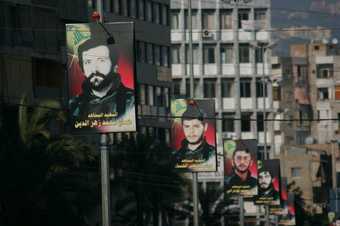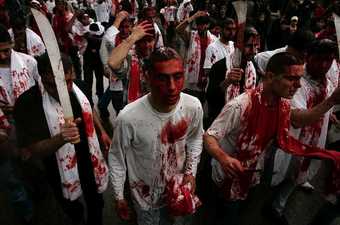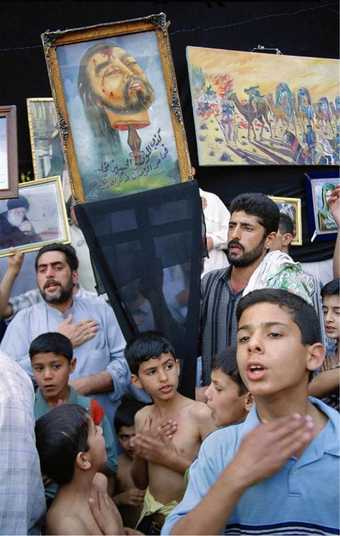On Three Posters looks back at a very specific moment in video history when the technology was being used by the Lebanese Left as a tool of ideological resistance.1 Rather than wait for a television crew to arrive, al-Sati used a readily available video camera to record his own message to the viewing public. Yet this address was not in itself sufficient; for it to be visible to the public it had to enter the dominant mass-cultural discourse of broadcast television news. When videos like al-Sati’s were aired on television, they were inevitably edited and attached to a voice-over commentary that influenced or directed the tape’s interpretation.
It should also be remembered that Al-Sati’s video appeared on television for only a very brief period and then disappeared from public view for over a decade. Mroué’s discovery of the uncut rushes years later in the offices of the Lebanese Communist Party occurred at a moment when analog video-tape based formats like Betamax and VHS were being rapidly replaced with digital cameras. This development also coincided with the rise of new online viewing platforms, signaling a shift from the centralised one-way communication of broadcast television to a decentralized, multi-directional model.
Today al-Sati’s can be viewed at any time on YouTube. There the video lives on not as a physical tape but as a digital file in a virtual archive that can be downloaded and re-circulated by anyone with a computer. Moreover, the widespread availability of digital editing software systems makes it easier to import and manipulate video or television footage. Analysing the changed terms of this new media landscape, the curator Nicholas Bourriaud argues that for contemporary artists of the digital era, ‘it is no longer a matter of elaborating a form on the basis of a raw material’ but rather devising strategies to ‘remix available forms and make use of data.’2 This analysis recognises that the power of images today lies not only in their production but also increasingly in their post-production: what Bourriaud defines as ‘the set of processes applied to recorded material: montage, the inclusion of other visual or audio sources, subtitling, voice-overs, and special effects’.3
Third take of Jamal al-Sati’s ‘martyr video’ 1985
Mroué’s most recent works not only employ programs like Powerpoint but respond in a critical fashion to the increasing use of digital technologies in the volatile Arab political sphere. In his lecture-performance The Inhabitants of Images 2009 Mroué analyses the digital manipulation of the body in Hezbollah’s Photoshop-designed martyr posters. Like Three Posters, The Inhabitants of Images is preoccupied with the re-animation of the dead in a culture that links pre-modern cult rituals with the most advanced forms of image production. Both works centre on the same question: what kind of agency is assigned to the dead in contemporary media? Noting how ‘dead people in photos move from one picture to another’, Mroué suggests that the departed can no longer find a final resting place in images: in the digital afterlife the faces of the dead are cloned ceaselessly within and across media. This insight applies not only to a country like Lebanon ‘where the inhabitants insist on calling upon the dead to use them as weapons in their endless battles’ but also to a global media landscape in which images, to an ever greater extent, behave nomadically, migrating from one medium to another.

Fig.1
Posters of Hezbollah martyrs in the southern suburbs of Beirut, 2006.
Photograph: Houssam Mcheimech
This points to the main issue addressed in the Inhabitants of Images, namely, the digital alteration of the body in banners of martyrs produced by Hezbollah after the July War with Israel in 2006. While posters of slain mujahedeen have traditionally served a commemorative function for the communities that they addressed, Mroué suggests that the banners of martyrs (fig.1) that appeared in the southern suburbs of Beirut after the July War testify to a shift in both the production and display of this iconography. These posters were displayed as large banners along the main roads in the Dahiyeh, the suburb of Beirut most heavily targeted by the Israeli aerial attacks. If the raised position of these images serves to underline the elevated status of these martyrs, their serial arrangement along the boulevard suggests that they are meant not so much to be looked at as scanned.
Yet if one looks closely it is possible to see that the head of each martyr has been cut and pasted onto a generic body with the aid of Photoshop. Accordingly, Mroué draws a fascinating link between the digital decapitation of these men’s heads in the posters and a foundational event in Shia collective memory: the original martyrdom of the Prophet Mohammad’s grandson Hussein Ibn Ali in the battle of Karbala. Shia rituals of remembrance, developed around the annual Day of Ashura, focus on the violent nature of his death (fig.2). The primary observances on Ashura consist of public expressions of mourning and self-mutilation that symbolically emulate and internalise Hussein’s beheading (fig.3). In these rituals Hussein’s suffering is taken to be a source of both deeply-rooted guilt and salvation. In the lecture-performance, Mroué points to the same structure of ‘reverse identification’ in the Hezbollah posters.4 However, whereas the rituals re-enact the violence inflicted on the martyr in order to atone for it, in these contemporary images the violence of martyrdom is effaced through a digital sleight of hand.

Fig.2
Islamic ritual on the Day of Ashura commemorating the martyrdom of Hussein Ibn Ali, photographed in Lebanon 2009.
Photo: Kate Brooks

Fig.3
The Day of Ashura with public expressions of mourning for the martyred Hussein Ibn Ali, photographed in Iraq in 2003.
© Abbas/Magnum Photos
For his part Mroué sees the generic bodies of Hezbollah’s martyrs as symptomatic of the party’s deeper fear of the body:
Does the society of war, or society of resistance, as they [Hezbollah] like to call it, fear the bodies of its members, to the extent that it amputates and throws them aside? Is it a fear of the body, and of the toxins it might secrete, always and forever? Is it for these reasons that the individual bodies are replaced with one body, strong, clean, and solid?5
Unlike the person who dies and leaves this world forever, the martyr gives up his life in order to come back to the world of the living, to fight, and to become a fallen martyr again. Mroué quotes the alleged words of the Prophet Mohammed as evidence of this belief: ‘No one enters Paradise and likes to come back to the world of the Living, except for the Martyr. For he wishes to return, and be killed ten times more.’6 What is interesting here is precisely the way in which this interpretation of martyrdom exploits the inherent properties of digital media. A digital image can be reproduced without loss of quality. However, the same cannot be said for a photographic negative or a VHS tape, which degrades with each subsequent copy or generation. The ephemeral image of martyrdom produced by Jamal al-Sati and the Lebanese Communist Party therefore stands in contrast to the digital logic of perfect and infinite reproduction. While Hezbollah’s martyrs are superior on a technical level, they lack the sense of fallibility that gives al-Sati’s video its humanity. This is not to suggest that al-Sati’s inner emotions or real intentions can be known. After all, his was a scripted performance staged for the camera. Psychoanalytic theory proposes that there is no real self behind the various roles a person adopts in public. Yet there is something in al-Sati’s halting delivery that makes it possible to glimpse, if only momentarily, the split between the image of the martyr and the flesh-and-blood person who comes to inhabit that image.
